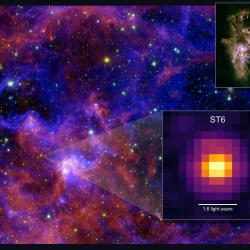Rosetta’s Onboard Camera Spots Philae Lander Drifting Across the Comet
The European Space Agency released today images showing the journey of the Rosetta spacecraft’s Philae lander as it approached and then rebounded from its first touchdown on Comet 67P/Churyumov–Gerasimenko on Nov. 12, 2014.
The images were taken with Rosetta’s onboard narrow-angle camera and show Philae descending toward and across the comet before touchdown. The image taken after touchdown confirms that the lander was moving east at a speed of about 0.5 meters per second (19 inches per second). The images of Comet 67P were captured when Rosetta was roughly 15.5 kilometers (9 miles) from the comet’s surface.
The narrow-angle camera, along with a wide-angle camera, comprises Rosetta’s Optical, Spectroscopic and Infrared Remote Imaging System (OSIRIS). The OSIRIS camera team includes two University of Maryland astronomers: Michael A’Hearn and Dennis Bodewits.
“The footprints the lander created when it first hit the comet will enable us to estimate the strength of the material at the surface of a comet,” said A’Hearn, a Distinguished University Professor Emeritus of astronomy at UMD.
The images will further the knowledge researchers gained from the Deep Impact mission, which measured (or at least set upper limits) on the strength deeper in the nucleus of a comet. A’Hearn served as principal investigator on the Deep Impact mission.
The final location of Philae is still not known, but researchers are confident that the images and data they have collected will reveal the lander’s whereabouts.
“We hope to still determine in the next few days where Philae finally ended its journey and knowing that will be crucial for putting the measurements by Philae's instruments in context,” added A’Hearn.
Rosetta’s mission will continue for another year and a half. A’Hearn and Bodewits expect to learn much more from OSIRIS about how the comet works and how it changes as it gets close to the sun.
For information on another instrument onboard Rosetta, called Alice, which is providing UMD researchers details of the comet's surface, visit https://cmns.umd.edu/news-events/news/umd-astronomers-analyze-surface-comet-spacecraft-drops-robotic-probe-it.
Media Relations Contact: Abby Robinson, 301-405-5845, abbyr@umd.edu
University of Maryland
College of Computer, Mathematical, and Natural Sciences
2300 Symons Hall
College Park, MD 20742
www.cmns.umd.edu
@UMDscience
About the College of Computer, Mathematical, and Natural Sciences
The College of Computer, Mathematical, and Natural Sciences at the University of Maryland educates more than 7,000 future scientific leaders in its undergraduate and graduate programs each year. The college's 10 departments and more than a dozen interdisciplinary research centers foster scientific discovery with annual sponsored research funding exceeding $150 million.







